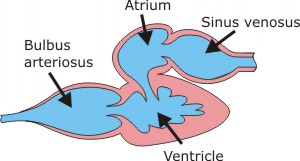четверг, 24 декабря 2015 г.
среда, 23 декабря 2015 г.
Internal organs and systems of organs of fish
Fishes have a closed circulatory system that pumps
blood in a single loop—from the heart to the gills, from the gills to the body,
and back to the heart. The heart is made up of four parts: the sinus venosus, atrium, ventricle, and bulbus arteriosus. The ventricle is the
actual pumping portion of the heart. The atrium is a one-way compartment for
blood that is going to enter the ventricle.
Fishes have well-developed nervous systems. The brain
has several parts. The olfactory bulbs and cerebrum are involved with the sense
of smell. The optic lobes process information from the eyes. The cerebellum
coordinates body movements.
Most fishes have a lateral line system that senses
currents and vibrations in the water. Most fishes move by contracting muscles
on either side of the backbone. Fins propel the fish forward and help it steer.
Many fishes have a gas-filled swim bladder that keeps them from sinking.
Подписаться на:
Комментарии (Atom)
The Father of Microbiology
1. Do you know who invented the first compound microscope? 2. Can you say who discovered bacteria, free-living and parasitic microscopic ...

-
A person’s home is as much a reflection of his personality as the clothes he wears, the food he eats and the friends he spends his time wi...
-
По большому счету обе формы допустимы, все зависит от значения, которое мы вкладываем с понятие «семья». Если мы говорим о семье как о «яч...






